AVL树
- AVL树定义:AVL树是一种自平衡二叉搜索树,每个节点都有一个平衡因子(左子树高度减去右子树高度),其值为 -1、0 或 +1。
- 节点旋转:为保持平衡,AVL树通过左旋、右旋、左-右旋和右-左旋四种旋转操作调整树的结构。
- 操作复杂度:在AVL树上执行插入、删除和搜索操作的时间复杂度均为O(log n),使其适用于大型数据库和索引记录。
AVL 树是一种自平衡二叉搜索树,其中每个节点维护额外的信息,称为平衡因子,其值为 -1、0 或 +1。
AVL 树以其发明者 Georgy Adelson-Velsky 和 Landis 的名字命名。
平衡因子
AVL 树中节点的平衡因子是该节点的左子树高度与右子树高度之差。
平衡因子 = (左子树高度 - 右子树高度)或(右子树高度 - 左子树高度)
AVL 树的自平衡特性由平衡因子维护。平衡因子的值应始终为 -1、0 或 +1。
一个平衡的 AVL 树的示例是:
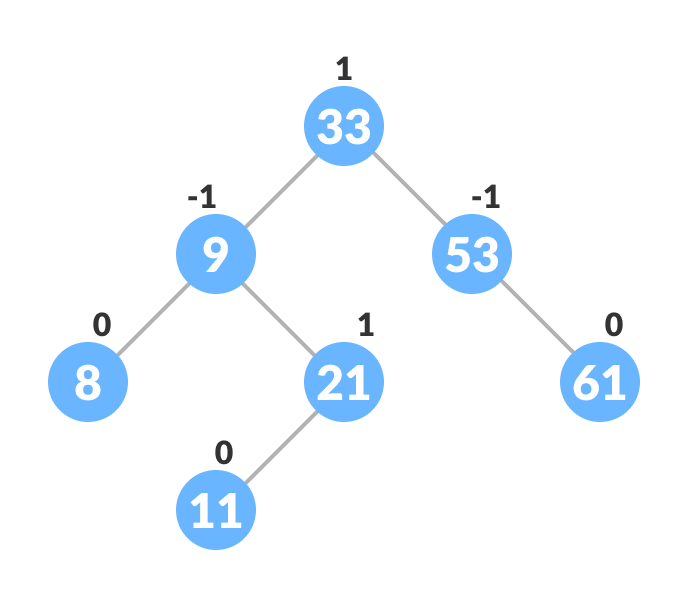
对 AVL 树的操作
可以在 AVL 树上执行的各种操作包括:
AVL 树中子树的旋转
在旋转操作中,子树的节点位置被交换。
旋转分为两种类型:
左旋
在左旋中,右侧节点的排列转换为左侧节点的排列。
算法
-
初始树为:
-
如果
y有左子树,则将x设为y的左子树的父节点。 -
如果
x的父节点为NULL,则使y成为树的根。 -
否则如果
x是其父节点p的左孩子,将y设为p的左孩子。 -
否则将
y设为p的右孩子。 -
将
y设为x的父节点。
右旋
在右旋中,左侧节点的排列转换为右侧节点的排列。
-
初始树为:
-
如果
x有右子树,则将y设为x的右子树的父节点。 -
如果
y的父节点为NULL,则使x成为树的根。 -
否则如果
y是其父节点p的右孩子,将x设为p的右孩子。 -
否则将
x设为p的左孩子。 -
将
x设为y的父节点。
左-右旋和右-左旋
在左-右旋转中,排列首先向左移动,然后向右移动。
-
对 x-y 执行左旋。
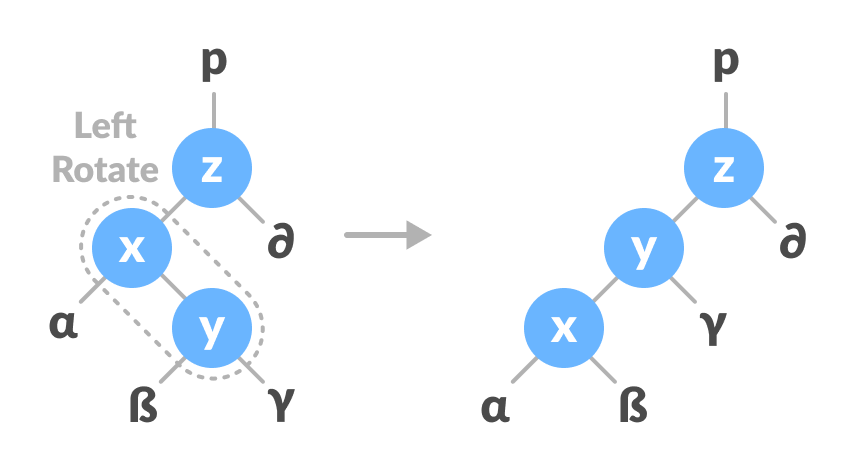
-
对 y-z 执行右旋。
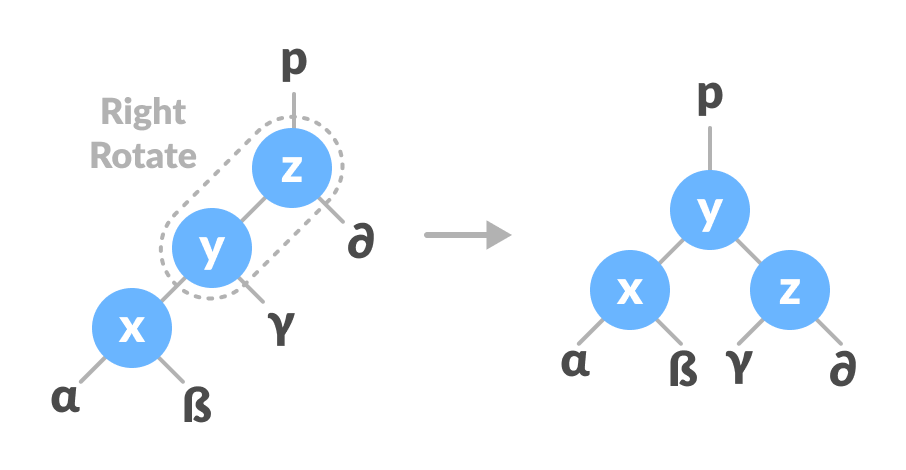
在右-左旋转中,排列首先向右移动,然后向左移动。
-
对 x-y 执行右旋。
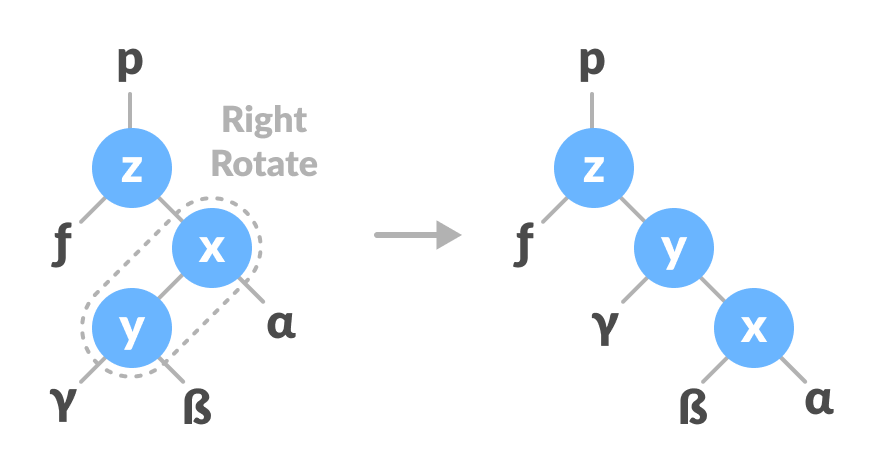
-
对 z-y 执行左旋。
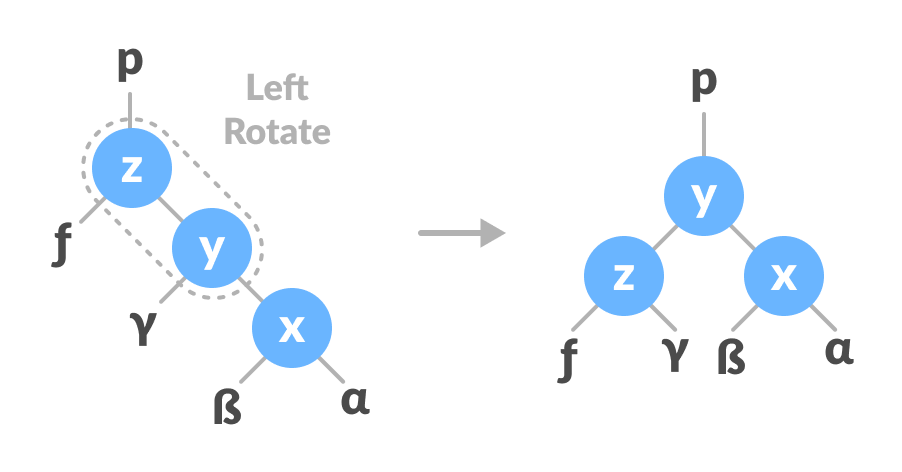
插入新节点的算法
新节点总是作为叶节点插入,其平衡因子等于 0。
- 初始树为:
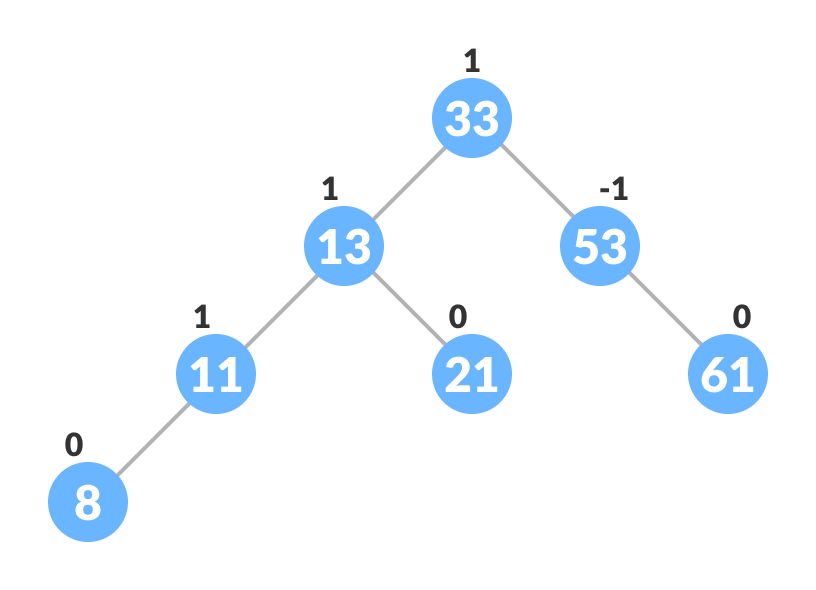
待插入的节点为:
- 使用以下递归步骤前往适当的叶节点以插入
newNode。将newKey与当前树的rootKey进行比较。 - 如果
newKey<rootKey,则对当前节点的左子树调用插入算法,直到达到叶节点。 - 否则如果
newKey>rootKey,则对当前节点的右子树调用插入算法,直到达到叶节点。 - 否则,返回
leafNode。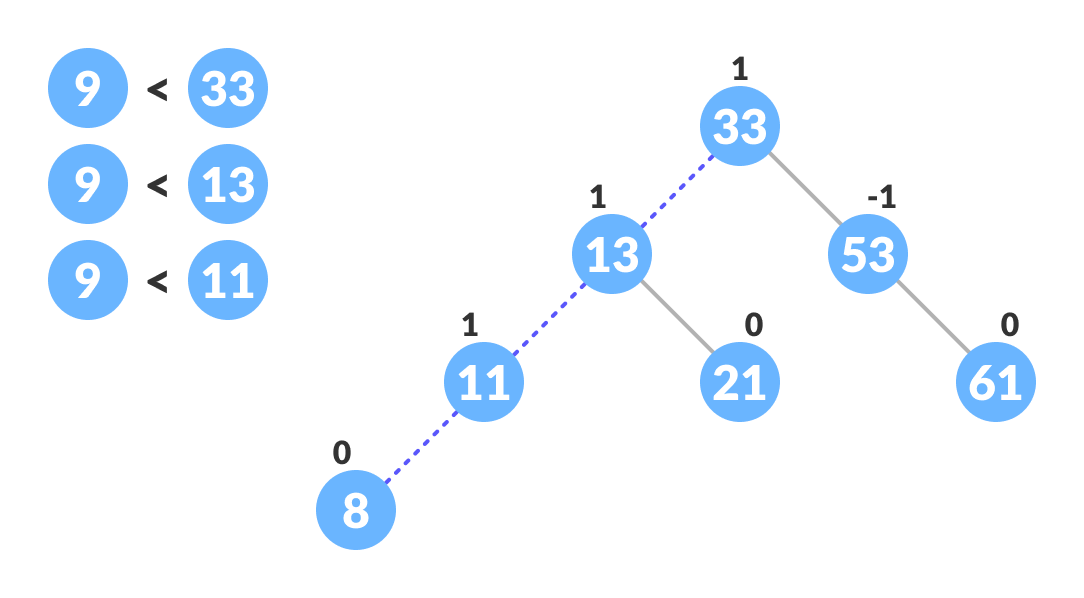
比较上述步骤获得的 leafKey 与 newKey:
- 如果
newKey<leafKey,则将 newNode 设为leafNode的leftChild。 - 否则,将
newNode设为leafNode的右孩子。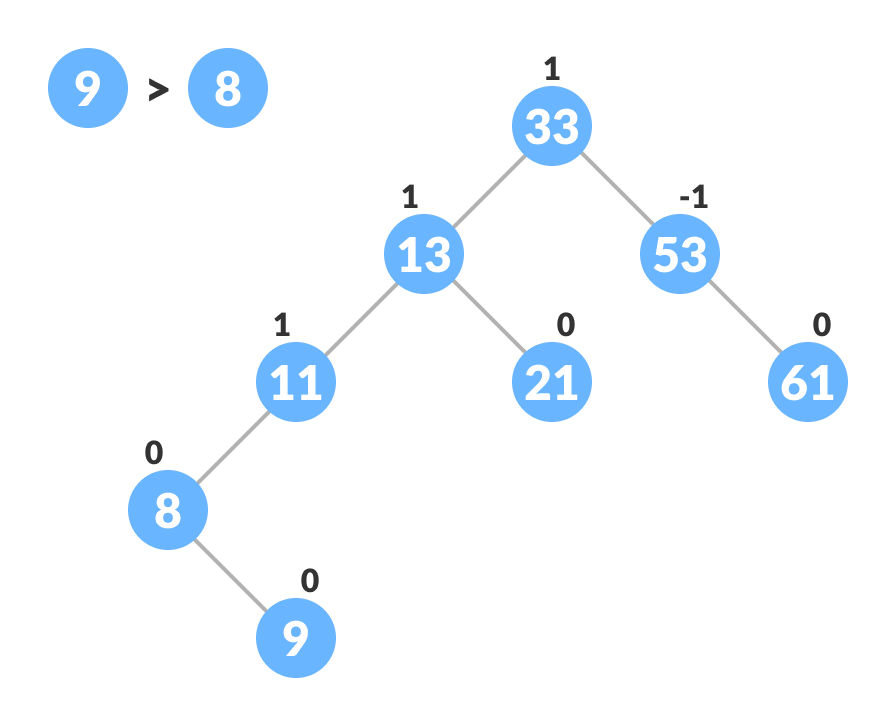
更新节点的 balanceFactor。
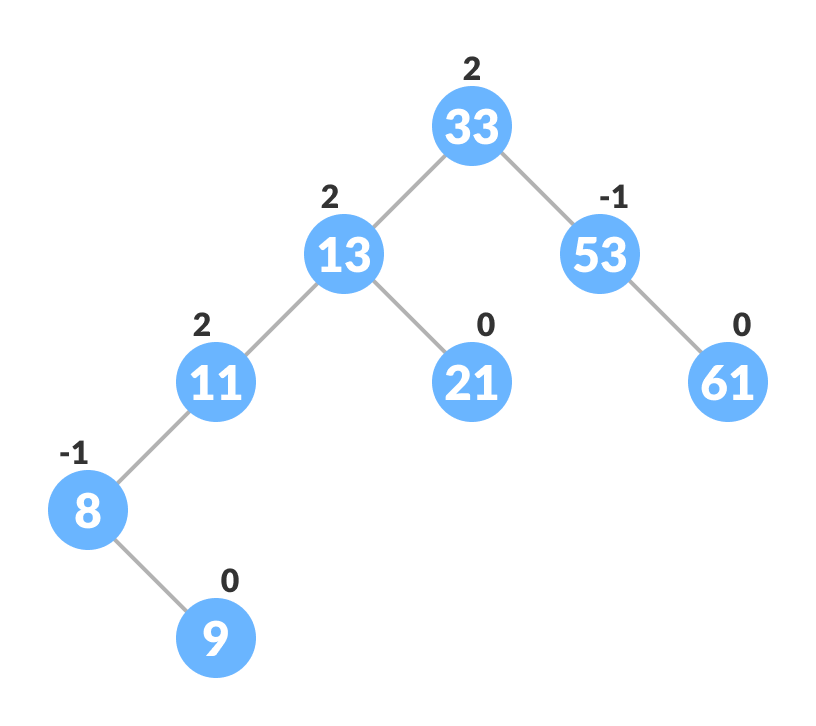 如果节点不平衡,则重新平衡该节点。
如果节点不平衡,则重新平衡该节点。
- 如果
balanceFactor> 1,意味着左子树的高度大于右子树的高度。因此,进行右旋转或左-右旋转。 - 如果
newNodeKey<leftChildKey,则进行右旋转。 - 否则,进行左-右旋转。
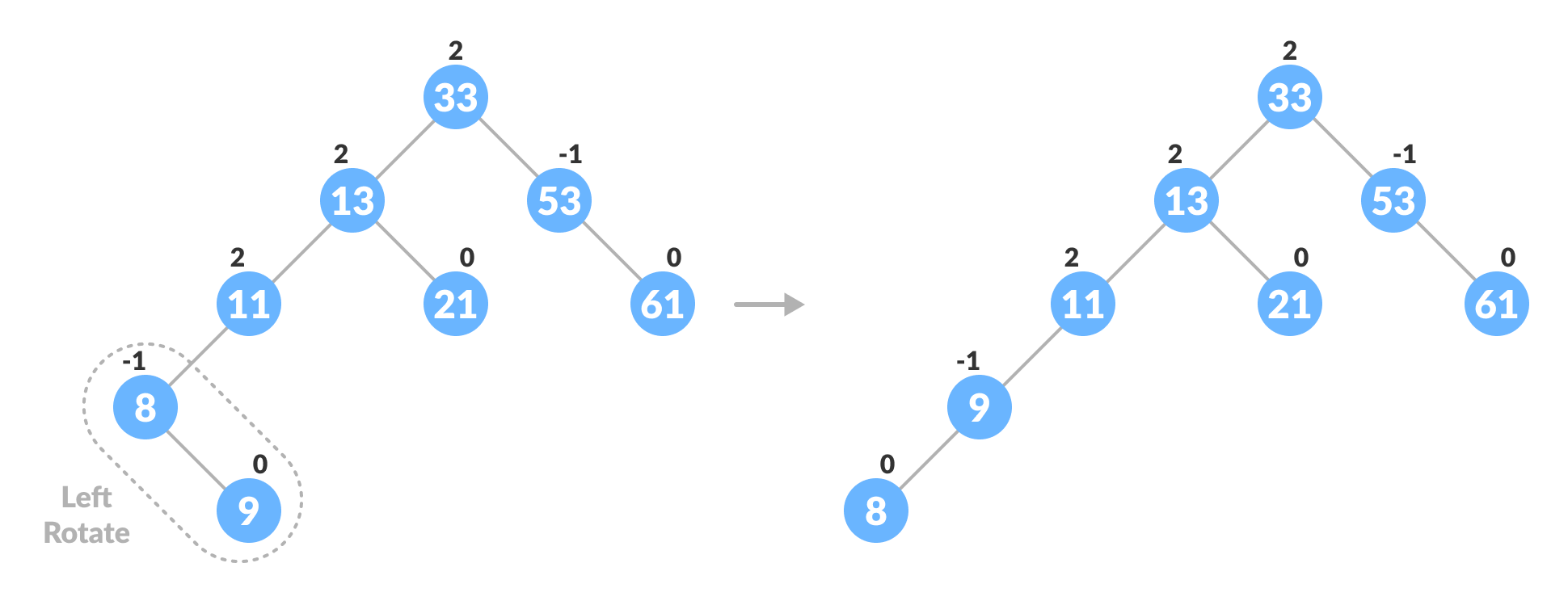
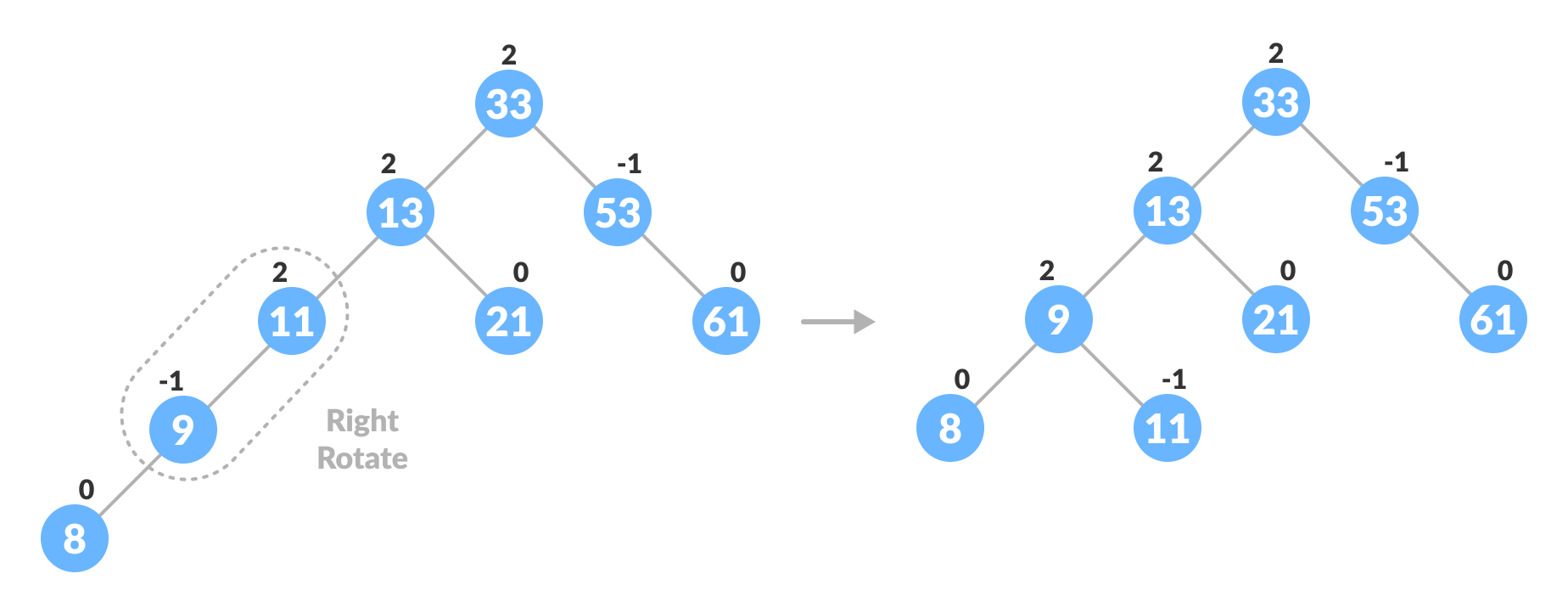
如果 balanceFactor < -1,意味着右子树的高度大于左子树的高度。因此,进行右旋转或右-左旋转。
- 如果
newNodeKey>rightChildKey,则进行左旋转。 - 否则,进行右-左旋转。
最终的树是:
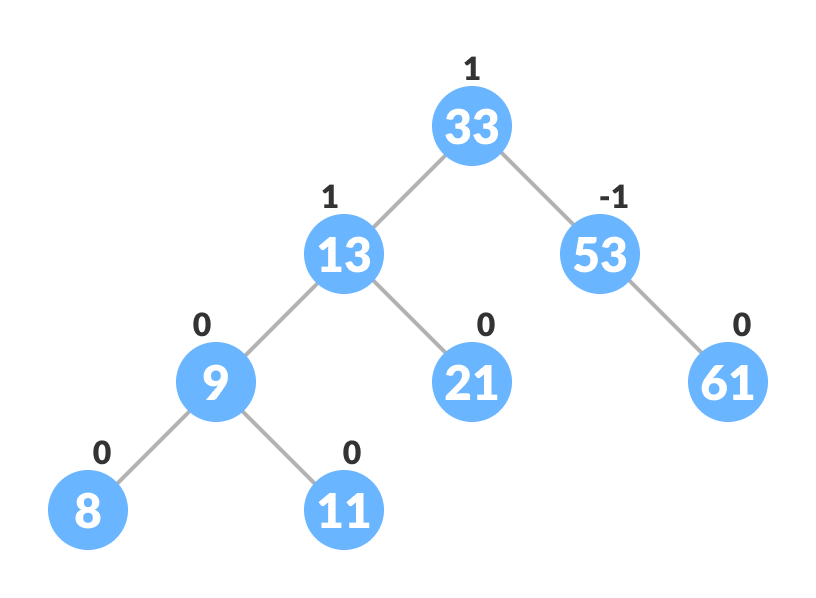
删除节点的算法
节点总是作为叶节点被删除。删除节点后,节点的平衡因子会发生变化。为了重新平衡平衡因子,执行适当的旋转。
-
定位
nodeToBeDeleted(在下面使用的代码中使用递归来查找nodeToBeDeleted)。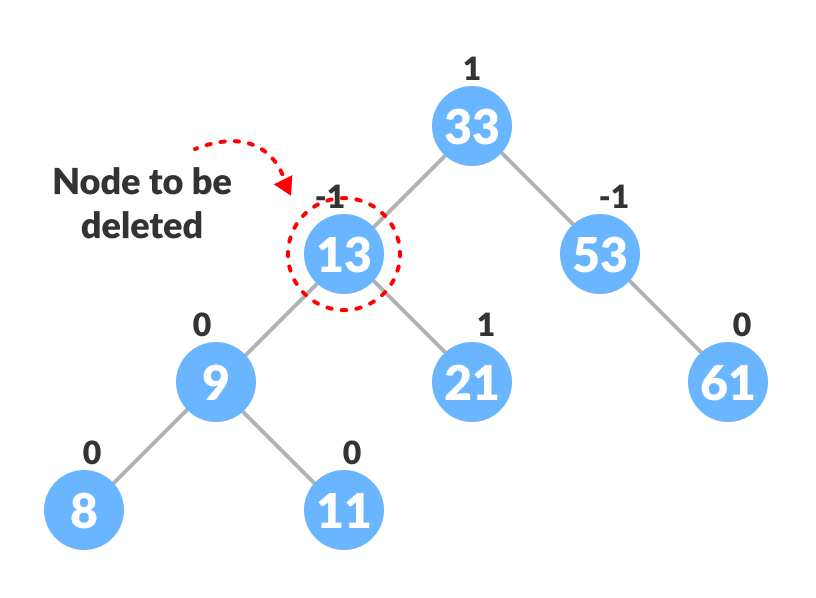
-
删除节点有三种情况:
-
如果
nodeToBeDeleted是叶节点(即没有任何子节点),则移除nodeToBeDeleted。 -
如果
nodeToBeDeleted有一个子节点,那么用子节点的内容替换nodeToBeDeleted的内容。移除该子节点。 -
如果
nodeToBeDeleted有两个子节点,找到nodeToBeDeleted的中序后继w(即右子树中键值最小的节点)。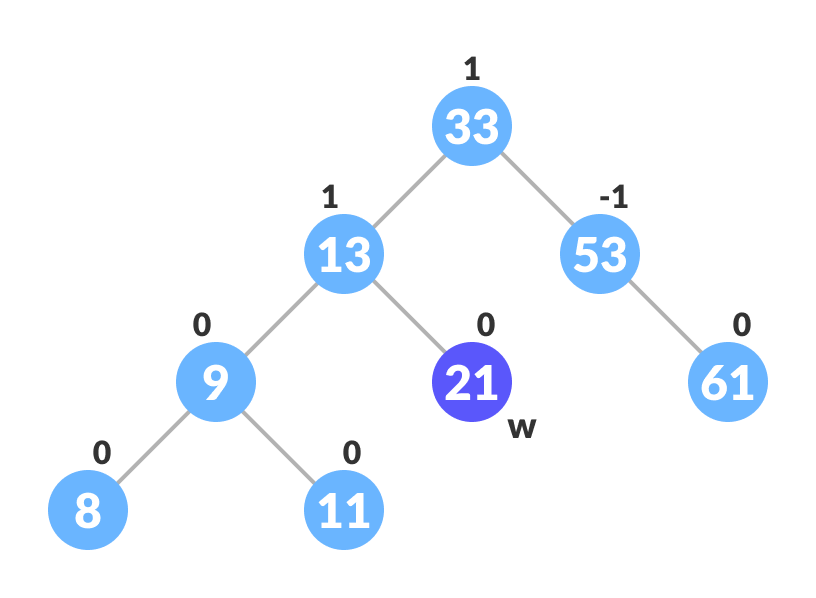
-
用
w的内容替换nodeToBeDeleted的内容。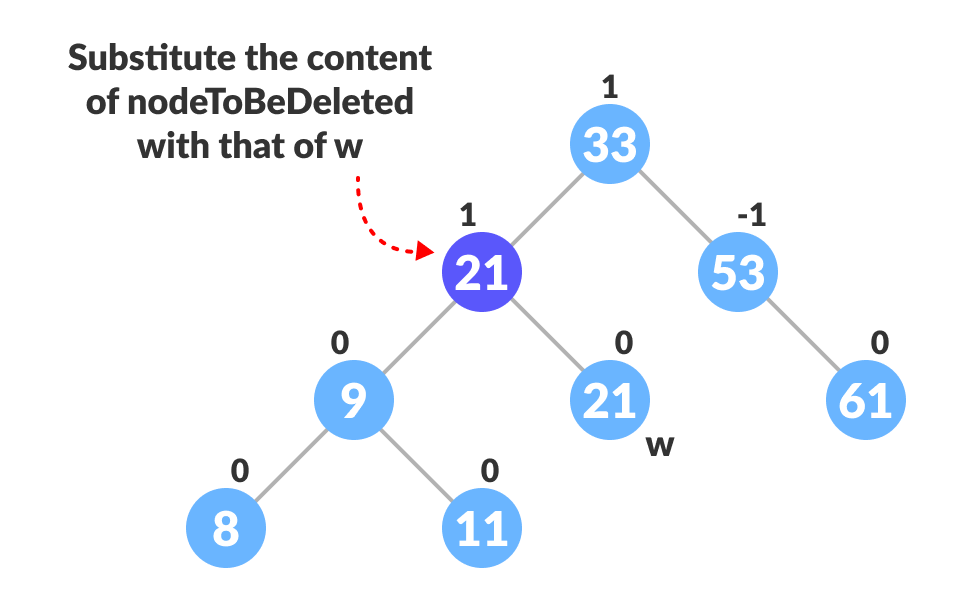
-
移除叶节点
w。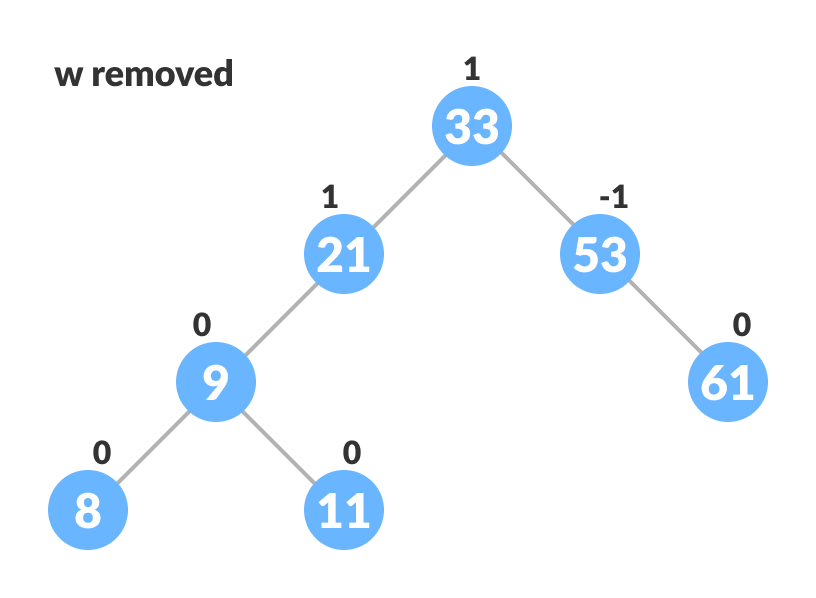
更新节点的 balanceFactor。
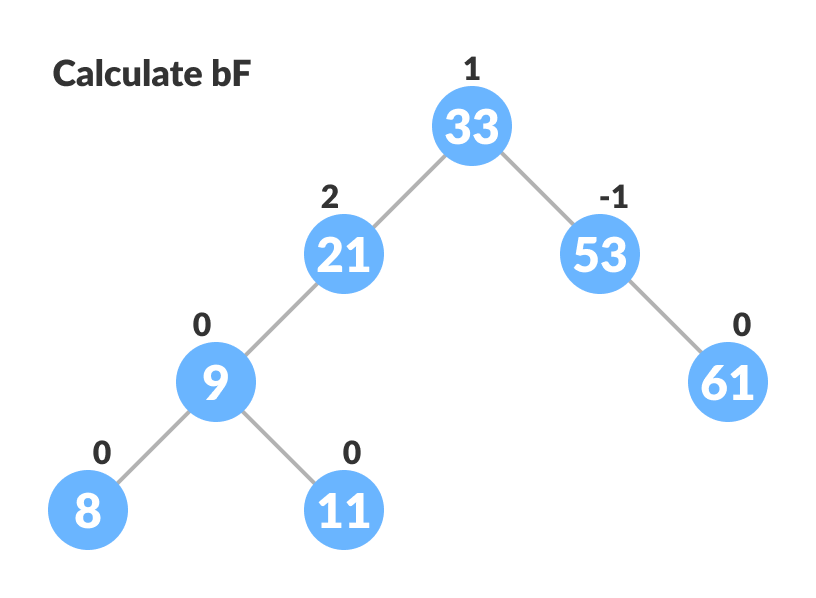
如果任何节点的平衡因子不等于 -1、0 或 1,重新平衡树。
-
如果
currentNode的balanceFactor> 1, -
如果
leftChild的balanceFactor≥ 0,进行右旋转。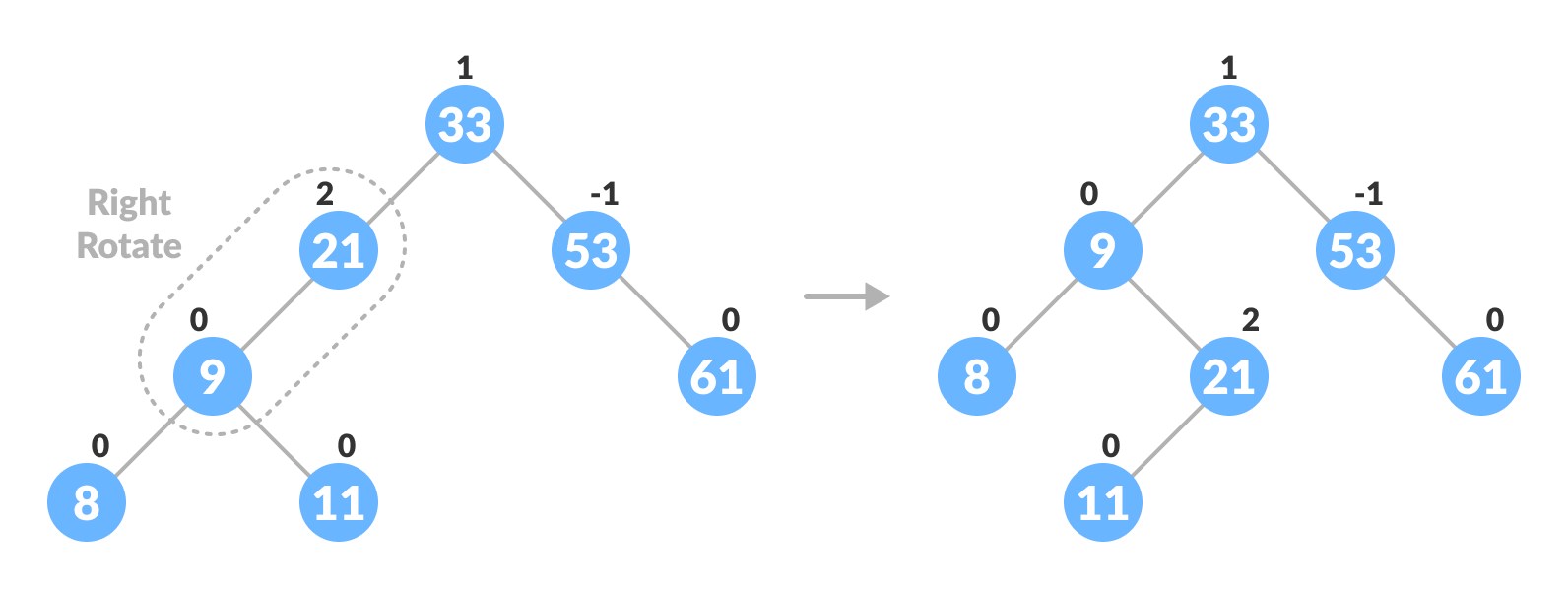
-
否则进行左-右旋转。
如果 currentNode 的 balanceFactor < -1,
- 如果
rightChild的balanceFactor≤ 0,进行左旋转。 - 否则进行右-左旋转。
最终的树是:

Python、Java 和 C/C++ 示例
# Python 中的 AVL 树实现
import sys
# 创建树节点
class TreeNode(object):
def __init__(self, key):
self.key = key
self.left = None
self.right = None
self.height = 1
class AVLTree(object):
# 插入节点的函数
def insert_node(self, root, key):
# 找到正确的位置并插入节点
if not root:
return TreeNode(key)
elif key < root.key:
root.left = self.insert_node(root.left, key)
else:
root.right = self.insert_node(root.right, key)
root.height = 1 + max(self.getHeight(root.left),
self.getHeight(root.right))
# 更新平衡因子并平衡树
balanceFactor = self.getBalance(root)
if balanceFactor > 1:
if key < root.left.key:
return self.right
Rotate(root)
else:
root.left = self.leftRotate(root.left)
return self.rightRotate(root)
if balanceFactor < -1:
if key > root.right.key:
return self.leftRotate(root)
else:
root.right = self.rightRotate(root.right)
return self.leftRotate(root)
return root
# 删除节点的函数
def delete_node(self, root, key):
# 找到要删除的节点并移除它
if not root:
return root
elif key < root.key:
root.left = self.delete_node(root.left, key)
elif key > root.key:
root.right = self.delete_node(root.right, key)
else:
if root.left is None:
temp = root.right
root = None
return temp
elif root.right is None:
temp = root.left
root = None
return temp
temp = self.getMinValueNode(root.right)
root.key = temp.key
root.right = self.delete_node(root.right,
temp.key)
if root is None:
return root
# 更新节点的平衡因子
root.height = 1 + max(self.getHeight(root.left),
self.getHeight(root.right))
balanceFactor = self.getBalance(root)
# 平衡树
if balanceFactor > 1:
if self.getBalance(root.left) >= 0:
return self.rightRotate(root)
else:
root.left = self.leftRotate(root.left)
return self.rightRotate(root)
if balanceFactor < -1:
if self.getBalance(root.right) <= 0:
return self.leftRotate(root)
else:
root.right = self.rightRotate(root.right)
return self.leftRotate(root)
return root
# 执行左旋转的函数
def leftRotate(self, z):
y = z.right
T2 = y.left
y.left = z
z.right = T2
z.height = 1 + max(self.getHeight(z.left),
self.getHeight(z.right))
y.height = 1 + max(self.getHeight(y.left),
self.getHeight(y.right))
return y
# 执行右旋转的函数
def rightRotate(self, z):
y = z.left
T3 = y.right
y.right = z
z.left = T3
z.height = 1 + max(self.getHeight(z.left),
self.getHeight(z.right))
y.height = 1 + max(self.getHeight(y.left),
self.getHeight(y.right))
return y
# 获取节点的高度
def getHeight(self, root):
if not root:
return 0
return root.height
# 获取节点的平衡因子
def getBalance(self, root):
if not root:
return 0
return self.getHeight(root.left) - self.getHeight(root.right)
def getMinValueNode(self, root):
if root is None or root.left is None:
return root
return self.getMinValueNode(root.left)
def preOrder(self, root):
if not root:
return
print("{0} ".format(root.key), end="")
self.preOrder(root.left)
self.preOrder(root.right)
# 打印树
def printHelper(self, currPtr, indent, last):
if currPtr != None:
sys.stdout.write(indent)
if last:
sys.stdout.write("R----")
indent += " "
else:
sys.stdout.write("L----")
indent += "| "
print(currPtr.key)
self.printHelper(currPtr.left, indent, False)
self.printHelper(currPtr.right, indent, True)
myTree = AVLTree()
root = None
nums = [33, 13, 52, 9, 21, 61, 8, 11]
for num in nums:
root = myTree.insert_node(root, num)
myTree.printHelper(root, "", True)
key = 13
root = myTree.delete_node(root, key)
print("After Deletion: ")
myTree.printHelper(root, "", True)
// Java 中 AVL 树的实现
// 创建节点
class Node {
int item, height;
Node left, right;
Node(int d) {
item = d;
height = 1;
}
}
// 树类
class AVLTree {
Node root;
int height(Node N) {
if (N == null)
return 0;
return N.height;
}
int max(int a, int b) {
return (a > b) ? a : b;
}
Node rightRotate(Node y) {
Node x = y.left;
Node T2 = x.right;
x.right = y;
y.left = T2;
y.height = max(height(y.left), height(y.right)) + 1;
x.height = max(height(x.left), height(x.right)) + 1;
return x;
}
Node leftRotate(Node x) {
Node y = x.right;
Node T2 = y.left;
y.left = x;
x.right = T2;
x.height = max(height(x.left), height(x.right)) + 1;
y.height = max(height(y.left), height(y.right)) + 1;
return y;
}
// 获取节点的平衡因子
int getBalanceFactor(Node N) {
if (N == null)
return 0;
return height(N.left) - height(N.right);
}
// 插入节点
Node insertNode(Node node, int item) {
// 查找位置并插入节点
if (node == null)
return (new Node(item));
if (item < node.item)
node.left = insertNode(node.left, item);
else if (item > node.item)
node.right = insertNode(node.right, item);
else
return node;
// 更新每个节点的平衡因子
// 并平衡树
node.height = 1 + max(height(node.left), height(node.right));
int balanceFactor = getBalanceFactor(node);
if (balanceFactor > 1) {
if (item < node.left.item) {
return rightRotate(node);
} else if (item > node.left.item) {
node.left = leftRotate(node.left);
return rightRotate(node);
}
}
if (balanceFactor < -1) {
if (item > node.right.item) {
return leftRotate(node);
} else if (item < node.right.item) {
node.right = rightRotate(node.right);
return leftRotate(node);
}
}
return node;
}
Node nodeWithMimumValue(Node node) {
Node current = node;
while (current.left != null)
current = current.left;
return current;
}
// 删除节点
Node deleteNode(Node root, int item) {
// 查找要删除的节点并移除
if (root == null)
return root;
if (item < root.item)
root.left = deleteNode(root.left, item);
else if (item > root.item)
root.right = deleteNode(root.right, item);
else {
if ((root.left == null) || (root.right == null)) {
Node temp = null;
if (temp == root.left)
temp = root.right;
else
temp = root.left;
if (temp == null) {
temp = root;
root = null;
} else
root = temp;
} else {
Node temp = nodeWithMimumValue(root.right);
root.item = temp.item;
root.right = deleteNode(root.right, temp.item);
}
}
if (root == null)
return root;
// 更新每个节点的平衡因子并平衡树
root.height = max(height(root.left), height(root.right)) + 1;
int balanceFactor = getBalanceFactor(root);
if (balanceFactor > 1) {
if (getBalanceFactor(root.left) >= 0) {
return rightRotate(root);
} else {
root.left = leftRotate(root.left);
return rightRotate(root);
}
}
if (balanceFactor < -1) {
if (getBalanceFactor(root.right) <= 0) {
return leftRotate(root);
} else {
root.right = rightRotate(root.right);
return leftRotate(root);
}
}
return root;
}
void preOrder(Node node) {
if (node != null) {
System.out.print(node.item + " ");
preOrder(node.left);
preOrder(node.right);
}
}
// 打印树
private void printTree
(Node currPtr, String indent, boolean last) {
if (currPtr != null) {
System.out.print(indent);
if (last) {
System.out.print("R----");
indent += " ";
} else {
System.out.print("L----");
indent += "| ";
}
System.out.println(currPtr.item);
printTree(currPtr.left, indent, false);
printTree(currPtr.right, indent, true);
}
}
// 驱动代码
public static void main(String[] args) {
AVLTree tree = new AVLTree();
tree.root = tree.insertNode(tree.root, 33);
tree.root = tree.insertNode(tree.root, 13);
tree.root = tree.insertNode(tree.root, 53);
tree.root = tree.insertNode(tree.root, 9);
tree.root = tree.insertNode(tree.root, 21);
tree.root = tree.insertNode(tree.root, 61);
tree.root = tree.insertNode(tree.root, 8);
tree.root = tree.insertNode(tree.root, 11);
tree.printTree(tree.root, "", true);
tree.root = tree.deleteNode(tree.root, 13);
System.out.println("删除后: ");
tree.printTree(tree.root, "", true);
}
}
// C 语言中的 AVL 树实现
#include <stdio.h>
#include <stdlib.h>
// 创建节点
struct Node {
int key;
struct Node *left;
struct Node *right;
int height;
};
int max(int a, int b);
// 计算高度
int height(struct Node *N) {
if (N == NULL)
return 0;
return N->height;
}
int max(int a, int b) {
return (a > b) ? a : b;
}
// 创建一个节点
struct Node *newNode(int key) {
struct Node *node = (struct Node *)
malloc(sizeof(struct Node));
node->key = key;
node->left = NULL;
node->right = NULL;
node->height = 1;
return (node);
}
// 右旋转
struct Node *rightRotate(struct Node *y) {
struct Node *x = y->left;
struct Node *T2 = x->right;
x->right = y;
y->left = T2;
y->height = max(height(y->left), height(y->right)) + 1;
x->height = max(height(x->left), height(x->right)) + 1;
return x;
}
// 左旋转
struct Node *leftRotate(struct Node *x) {
struct Node *y = x->right;
struct Node *T2 = y->left;
y->left = x;
x->right = T2;
x->height = max(height(x->left), height(x->right)) + 1;
y->height = max(height(y->left), height(y->right)) + 1;
return y;
}
// 获取平衡因子
int getBalance(struct Node *N) {
if (N == NULL)
return 0;
return height(N->left) - height(N->right);
}
// 插入节点
struct Node *insertNode(struct Node *node, int key) {
// 找到正确的位置插入节点
if (node == NULL)
return (newNode(key));
if (key < node->key)
node->left = insertNode(node->left, key);
else if (key > node->key)
node->right = insertNode(node->right, key);
else
return node;
// 更新每个节点的平衡因子并平衡树
node->height = 1 + max(height(node->left),
height(node->right));
int balance = getBalance(node);
if (balance > 1 && key < node->left->key)
return rightRotate(node);
if (balance < -1 && key > node->right->key)
return leftRotate(node);
if (balance > 1 && key > node->left->key) {
node->left = leftRotate(node->left);
return rightRotate(node);
}
if (balance < -1 && key < node->right->key) {
node->right = rightRotate(node->right);
return leftRotate(node);
}
return node;
}
struct Node *minValueNode(struct Node *node) {
struct Node *current = node;
while (current->left != NULL)
current = current->left;
return current;
}
// 删除节点
struct Node *deleteNode(struct Node *root, int key) {
// 查找并删除节点
if (root == NULL)
return root;
if (key < root->key)
root->left = deleteNode(root->left, key);
else if (key > root->key)
root->right = deleteNode(root->right, key);
else {
if ((root->left == NULL) || (root->right == NULL)) {
struct Node *temp = root->left ? root->left : root->right;
if (temp == NULL) {
temp = root;
root = NULL;
} else
*root = *temp;
free(temp);
} else {
struct Node *temp = minValueNode(root->right);
root->key = temp->key;
root->right = deleteNode(root->right, temp->key);
}
}
if (root == NULL)
return root;
// 更新每个节点的平衡因子并平衡树
root->height = 1 + max(height(root->left),
height(root->right));
int balance = getBalance(root);
if (balance > 1 && getBalance(root->left) >= 0)
return rightRotate(root);
if (balance > 1 && getBalance(root
->left) < 0) {
root->left = leftRotate(root->left);
return rightRotate(root);
}
if (balance < -1 && getBalance(root->right) <= 0)
return leftRotate(root);
if (balance < -1 && getBalance(root->right) > 0) {
root->right = rightRotate(root->right);
return leftRotate(root);
}
return root;
}
// 打印树
void printPreOrder(struct Node *root) {
if (root != NULL) {
printf("%d ", root->key);
printPreOrder(root->left);
printPreOrder(root->right);
}
}
int main() {
struct Node *root = NULL;
root = insertNode(root, 2);
root = insertNode(root, 1);
root = insertNode(root, 7);
root = insertNode(root, 4);
root = insertNode(root, 5);
root = insertNode(root, 3);
root = insertNode(root, 8);
printPreOrder(root);
root = deleteNode(root, 3);
printf("\nAfter deletion: ");
printPreOrder(root);
return 0;
}
// C++ 中的 AVL 树实现
#include <iostream>
using namespace std;
class Node {
public:
int key;
Node *left;
Node *right;
int height;
};
int max(int a, int b);
// 计算高度
int height(Node *N) {
if (N == NULL)
return 0;
return N->height;
}
int max(int a, int b) {
return (a > b) ? a : b;
}
// 创建新节点
Node *newNode(int key) {
Node *node = new Node();
node->key = key;
node->left = NULL;
node->right = NULL;
node->height = 1;
return (node);
}
// 向右旋转
Node *rightRotate(Node *y) {
Node *x = y->left;
Node *T2 = x->right;
x->right = y;
y->left = T2;
y->height = max(height(y->left),
height(y->right)) +
1;
x->height = max(height(x->left),
height(x->right)) +
1;
return x;
}
// 向左旋转
Node *leftRotate(Node *x) {
Node *y = x->right;
Node *T2 = y->left;
y->left = x;
x->right = T2;
x->height = max(height(x->left),
height(x->right)) +
1;
y->height = max(height(y->left),
height(y->right)) +
1;
return y;
}
// 获取每个节点的平衡因子
int getBalanceFactor(Node *N) {
if (N == NULL)
return 0;
return height(N->left) -
height(N->right);
}
// 插入节点
Node *insertNode(Node *node, int key) {
// 找到正确位置并插入节点
if (node == NULL)
return (newNode(key));
if (key < node->key)
node->left = insertNode(node->left, key);
else if (key > node->key)
node->right = insertNode(node->right, key);
else
return node;
// 更新每个节点的平衡因子并平衡树
node->height = 1 + max(height(node->left),
height(node->right));
int balanceFactor = getBalanceFactor(node);
if (balanceFactor > 1) {
if (key < node->left->key) {
return rightRotate(node);
} else if (key > node->left->key) {
node->left = leftRotate(node->left);
return rightRotate(node);
}
}
if (balanceFactor < -1) {
if (key > node->right->key) {
return leftRotate(node);
} else if (key < node->right->key) {
node->right = rightRotate(node->right);
return leftRotate(node);
}
}
return node;
}
// 具有最小值的节点
Node *nodeWithMimumValue(Node *node) {
Node *current = node;
while (current->left != NULL)
current = current->left;
return current;
}
// 删除节点
Node *deleteNode(Node *root, int key) {
// 找到节点并删除
if (root == NULL)
return root;
if (key < root->key)
root->left = deleteNode(root->left, key);
else if (key > root->key)
root->right = deleteNode(root->right, key);
else {
if ((root->left == NULL) ||
(root->right == NULL)) {
Node *temp = root->left ? root->left : root->right;
if (temp == NULL) {
temp = root;
root = NULL;
} else
*root = *temp;
free(temp);
} else {
Node *temp = nodeWithMimumValue(root->right);
root->key = temp->key;
root->right = deleteNode(root->right,
temp->key);
}
}
if (root == NULL)
return root;
// 更新每个节点的平衡因子并平衡树
root->height = 1 + max(height(root->left),
height(root->right));
int balanceFactor = getBalanceFactor(root);
if (balanceFactor > 1) {
if (getBalanceFactor(root->left) >=0) {
return rightRotate(root);
} else {
root->left = leftRotate(root->left);
return rightRotate(root);
}
}
if (balanceFactor < -1) {
if (getBalanceFactor(root->right) <= 0) {
return leftRotate(root);
} else {
root->right = rightRotate(root->right);
return leftRotate(root);
}
}
return root;
}
// 打印树
void printTree(Node *root, string indent, bool last) {
if (root != nullptr) {
cout << indent;
if (last) {
cout << "R----";
indent += " ";
} else {
cout << "L----";
indent += "| ";
}
cout << root->key << endl;
printTree(root->left, indent, false);
printTree(root->right, indent, true);
}
}
int main() {
Node *root = NULL;
root = insertNode(root, 33);
root = insertNode(root, 13);
root = insertNode(root, 53);
root = insertNode(root, 9);
root = insertNode(root, 21);
root = insertNode(root, 61);
root = insertNode(root, 8);
root = insertNode(root, 11);
printTree(root, "", true);
root = deleteNode(root, 13);
cout << "删除后:" << endl;
printTree(root, "", true);
}
不同操作在 AVL 树上的复杂度
| 插入 | 删除 | 搜索 | | O(log n)| O(log n)| O(log n) |
AVL 树的应用
- 用于在数据库中索引大量记录
- 用于在大型数据库中进行搜索